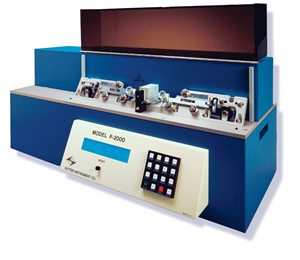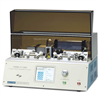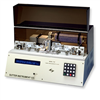

P-2000
Laser-Based Micropipette Puller from Sutter- Overview
- Specifications
- Accessories
- Citations
- Related Products
Overview

There are 1 images available to view - click to enlarge and scroll through the product gallery.
Which P-2000 version do I need?
/ Download as PDF
P-2000 Flyer
/ Download as PDF
P-2000 Manual
/ Download as PDF
- Capable of pulling quartz, borosilicate and aluminosilicate glass.
- Fully programmable - including heating filament characteristics.
- The laser has no melting point limit as with conventional metal filaments; and therefore, cannot be burned out.
- Pulls electrodes with tip diameters smaller than 0.03µm.
- Optimized velocity sensing circuit for maximized sensitivity and reproducibility.*
- Operating life of the CO2 laser is expected to be in excess of ten years with normal use, after which the laser can be refurbished by the Sutter Instrument Company for a nominal charge.
- Individual programs can be write-protected in order to secure them from inadvertent changes.
- The total time that the heat is on during the pull is displayed for improved program development and troubleshooting.
- A date and time stamp is displayed to show the last time that a program has been changed.
- The P-2000/F is ideal for applications such as nanospray and NSOM.
- Preprogrammed sample programs for intra-cellular and patch pipettes. The P-2000/F also comes with an NSOM tip program.
The P-2000 micropipette puller represents a significant advance in the technology of fabrication of micropipettes, optical fiber probes, and nanospray tips. The P-2000 integrates a CO2 laser-based heat source with the technology derived from our extensive experience with conventional pullers. This system offers capabilities unmatched by other pullers.
While the P-2000 is suitable for working with most conventional glasses, its primary advantage is the ability to work with quartz glass (fused silica). Quartz offers superior material properties for a variety of research applications. Quartz is stronger than other glasses and can facilitate penetration through tough tissues which would normally break conventional pipettes1 . For applications requiring a low noise glass, users will find that quartz is the lowest noise glass available2,4. Quartz contains none of the metals used in conventional glasses3. Optically, quartz is virtually free from fluorescence when illuminated.
A CO2 laser was selected as the heat source for the P-2000 for several reasons. First, the nominal emission wavelength of the laser approximates the resonant frequency of the SiO2 lattice in glass. Thus, quartz and other conventional glasses can be melted when the appropriate laser power is supplied. Second, laser heat is clean and leaves no metal residue on the pipette as do conventional heating filaments. Third, laser heat can be turned off instantly, leaving no residual filament heat. Lastly, the user can program the amount and distribution of heat supplied to the glass.
The P-2000 can store up to 100 separate programs, with each program consisting of up to 8 command lines. Programmable parameters include; laser power level, scan width, trip velocity, delay/ laser on time, and hard pull strength.
One important consideration for the use of the P-2000 is the diameter of the glass used. The P-2000/G is designed to produce even heating on glass up to 1.2 mm in outside diameter. Larger diameter glasses can be used with the P-2000/G (up to 1.5 mm quartz and 1.8 mm conventional glasses), but the performance is best with glass that is 1.2 mm diameter or less.
The P-2000/F works well with small diameter glasses such as optical fibers, and with small diameter fused silica capillary commonly used for the manufacture of nanospray tips. Small diameter glass (outer diameter in the range of 0.125 mm to 0.6 mm) requires special puller bars as well as an optical alignment optimized for the smaller diameter material.
As with larger diameter glass, a wide range of tip sizes and taper geometries can be produced with the P-2000/F and small diameter glass. We have drawn optical fiber tips ranging from less than 10nm to more than 5µm. Please consult our technical staff for further information.
REFERENCES
These references describe the Flaming/Brown pullers and contain valuable information applicable to the P-2000.
1 Munoz, J.L. and Coles, J. Quartz micropipettes for intracellular voltage micro- electrodes and ion selective microelectrodes. Journal of Neuroscience Methods: 22:57-64, 1987.
2 Rae, J.L. and Levis, R. A. A method for exceptionally low noise single channel recordings. European Journal of Physiology - Pflügers Archiv: 420:618-620, 1992.
3 Zuazaga, C. and Steinacker, A. Patch-clamp recording of ion channels: Interfering effects of patch pipette glass. News in Physiological Science: 5:155-159, 1990.
4 Levis, R.A. and Rae, J. L. The use of quartz patch pipettes for low noise single channel recording. Biophysical Journal: 65:1666-1677, 1993.
Specifications
TECHNICAL SPECIFICATIONS
Dimensions
30in x 14.25in x 13.25in 76cm x 36cm x 33.5cm
Weight
80 lbs | 36 kg
Electrical
115/230 volts 50/60 Hertz power line
*Patent No.4,600,424
CLASS 1 LASER PRODUCT
Accessories
Citations
Anderson, L., English, A., & Wang, W. (2014). Protein derivatization and sequential ion/ion reactions to enhance sequence coverage produced by electron transfer dissociation mass spectrometry. International Journal of …. Retrieved from https://www.sciencedirect.com/science/article/pii/S1387380614002498
Clausmeyer, J., & Actis, P. (2014). Nanosensors for the detection of hydrogen peroxide. Electrochemistry …. Retrieved from https://www.sciencedirect.com/science/article/pii/S1388248113004797
Eckhard, U., & Huesgen, P. (2014). Proteomic protease specificity profiling of clostridial collagenases reveals their intrinsic nature as dedicated degraders of collagen. Journal of proteomics. Retrieved from https://www.sciencedirect.com/science/article/pii/S1874391913005137
Goulding, S., MacCoss, M., & Wu, C. (2013). Label-Free Differential Analysis of Murine Postsynaptic Densities. Proteomics for Biomarker Discovery. Retrieved from https://link.springer.com/protocol/10.1007/978-1-62703-360-2_22
Güell, A., Meadows, K., & Dudin, P. (2014). Selection, characterisation and mapping of complex electrochemical processes at individual single-walled carbon nanotubes: the case of serotonin oxidation. Faraday …. Retrieved from https://pubs.rsc.org/en/content/articlehtml/2014/fd/c4fd00054d
Hosford, P., Mifflin, S., & Ramage, A. (2014). 5-Hydroxytryptamine–Mediated Neurotransmission Modulates Spontaneous and Vagal-Evoked Glutamate Release in the Nucleus of the Solitary Tract Effect of. Journal of Pharmacology and …. Retrieved from https://jpet.aspetjournals.org/content/349/2/288.short
Johansson, B., & Höök, F. (2014). Label-Free Measurements of the Diffusivity of Molecules in Lipid Membranes. …. Retrieved from https://onlinelibrary.wiley.com/doi/10.1002/cphc.201301136/full
Jones, C., Luong, T., & Hannon, M. (2013). Heterologous expression of the C-terminal antigenic domain of the malaria vaccine candidate Pfs48/45 in the green algae Chlamydomonas reinhardtii. Applied microbiology …. Retrieved from https://link.springer.com/article/10.1007/s00253-012-4071-7
Lange, W., & Jin, L. (2014). Recombinant Adeno-associated virus (rAAV)-mediated transduction and optogenetic manipulation of cortical neurons in vitro. SPIE …. Retrieved from https://proceedings.spiedigitallibrary.org/proceeding.aspx?articleid=1841446
Miragoli, M., & Novak, P. (2013). Functional interaction between charged nanoparticles and cardiac tissue: a new paradigm for cardiac arrhythmia? …. Retrieved from https://www.futuremedicine.com/doi/abs/10.2217/nnm.12.125
Novak, P., Gorelik, J., & Vivekananda, U. (2013). Nanoscale-targeted patch-clamp recordings of functional presynaptic ion channels. Neuron. Retrieved from https://www.sciencedirect.com/science/article/pii/S0896627313006120
Novak, P., Li, C., & Shevchuk, A. (2013). Scanning ion conductance microscopy using surface roughness for probe movement. US Patent App. 13/ …. Retrieved from https://www.google.com/patents/US20130312143
Wang, F., Zhang, Y., Chen, Y., He, Y., & Qi, J. (2014). Methanotrophic archaea possessing diverging methane-oxidizing and electron-transporting pathways. The ISME …. Retrieved from https://www.nature.com/ismej/journal/v8/n5/abs/ismej2013212a.html
Wang, H., Shi, Q., & Nakajima, M. (2014). Rail-guided Multi-robot System for 3D Cellular Hydrogel Assembly with Coordinated Nanomanipulation. Int J Adv Robot …. Retrieved from https://cdn.intechopen.com/pdfs-wm/47329.pdf
Zhang, L., Liu, J., Yang, B., Kang, X., & Jiang, S. (2013). Optimized fabrication of micropipette using laser micromachining process and application in functional electrical stimulation of muscle tissue. Microelectronic …. Retrieved from https://www.sciencedirect.com/science/article/pii/S0167931712005606






Request
Catalogue
Chat
Print